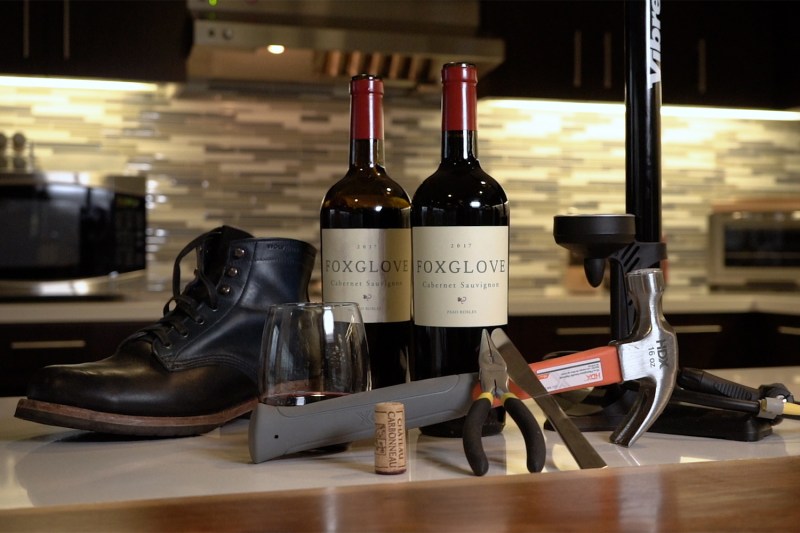
It happens to the best of us: You’ve set up camp in the woods or unpacked your gear in a barebones hotel, and it dawns on you — you have no corkscrew! The bottle of wine you wanted to enjoy is now mocking your forgetful ways.
If the internet has taught us anything, it’s that there’s a hack for everything. Turns out, the wine world is full of MacGyvers. Crafty imbibers employ everything from bike pumps to shoes to extract pesky corks. And while it isn’t as easy as opening a beer without a bottle opener, it is possible.
Wine is becoming increasingly portable and lower-brow, as screw caps, wine in boxes, and the canned wine movement all suggest, but the majority of wine still comes in the traditional bottle, especially the really good stuff. Besides, these methods are so fun you’re going to want to try them out whether you’re in a jam or not.
Not since sabering has opening a bottle felt so triumphant. Now, let us share some of the best tips on how to open a wine bottle without a corkscrew.
4 ways to open wine without a corkscrew

So there’s not just one way to work the magic of how to open wine bottles without corkscrews in hand — there are four to pick from:
- Poke-through method
- Bike pump method
- Shoe method
- Port tongs method
Each offers a different level of tools, difficulty, and showmanship, so you might want to learn all four, just in case.
The poke-through method
It’s caveman-esque, but generally effective. The poke-through involves hammering a blunt object into the cork so that it falls into the wine itself. You’re left with a bobbing — and sometimes crumbled — cork that partially clogs the neck, but it’s arguably the quickest way to get to drinking. And you’re probably camping, so presentation isn’t exactly on your list of priorities.
A sturdy stick bashed by a rock will do the trick, but an actual hammer or something similar is best. Be forceful but careful not to strike the glass. A cooler version involves a serrated knife, should you have one. Push the knife into the cork, allowing the teeth of the blade to latch on. Pull and twist and you should be able to extract the cork, in a decidedly badass fashion.
The bike pump method
Pressure is your friend. With this method, poke a small hole completely through the cork with a nail, screw, or the like. Put your bike pump needle in the hole and pump until the cork is pushed out. Too much pressure will result in some wine loss, so start easy and up the ante as needed. Once the cork is pushed out enough to get a hold of it (with your hands or pliers), you should be able to pull the rest out of the bottle.
The shoe method
Reliable in that you’re almost always in the company of shoes, this method is a little messy. It is also probably the most-attempted method out there, per a deep well of internet videos. The heel of most shoes creates a nice padded nest to cup the base of the bottle. This will protect the wine as you savagely beat it against a wall, tree trunk, or sheer rock face. It’s best to let the wine rest for a short while before pulling out the protruding cork. That way, the pressure will subside and you won’t lose any precious juice.
The port tongs method
This is a method perfect for older, more valuable bottles of wine, specifically port wines. It’s more involved, but it will preserve the wine that resides beneath a tired old cork. Opened the traditional way, these aged gems are prone to deteriorate old cork bits. Taylor’s Port calls on heated tongs to get the job done. Wonderfully showy, this method is as much a party trick as it is a way to get at a wine without the conventional tools at hand.
What not to do

Now that we’ve shared with you some ways you could get that wine bottle open if you don’t have a corkscrew, we really feel obligated to warn you about some ways that you should absolutely not try.
Breaking the bottle’s neck
The picture above shows someone sabering open a bottle of champagne with a large knife. It looks cool, doesn’t it? Yeah, don’t try this with a nice bottle of red, you’ll end up with a mess at best and shards of broken glass in your wine at worst. Sabering only works for sparkling wines because of the pressure inside the bottle, and if the bottle is not chilled to the right temperature, it could explode. As cool as it looks, it just isn’t worth it.
Using a power drill
It may look corkscrew-esque, but a power drill is not the answer to getting into that wine bottle. If you drill a hole through the cork, the wine will pour out so slowly that the party will be over before your glass is half full. If you try to destroy the cork with the drill, all you’ll get is pieces of cork and cork dust in your wine, and you also run the risk of shattering the bottle if the drill hits the glass.


